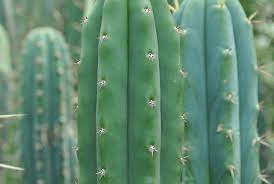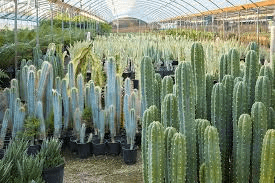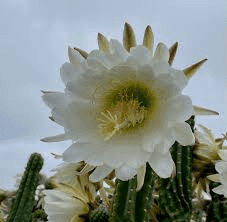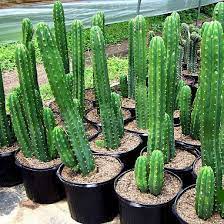Echinopsis pachanoi, commonly known as San Pedro cactus, is a species of columnar cactus native to the Andes Mountains in South America. This cactus holds cultural, spiritual, and medicinal significance, particularly among indigenous communities in the Andean region.
San Pedro cactus is characterized by its tall, ribbed stems that can reach heights of several meters. The stems are usually bluish-green and have clusters of small, sharp spines. The cactus produces white or yellowish flowers, and it’s known for its rapid growth under favorable conditions.
The indigenous people of the Andes, particularly in Peru and Ecuador, have a long history of using Echinopsis pachanoi in traditional medicine and shamanic rituals.
The cactus contains various alkaloids, including mescaline, a naturally occurring psychedelic compound. Mescaline is known for its hallucinogenic effects, and the use of San Pedro cactus in traditional ceremonies is believed to facilitate spiritual experiences, introspection, and healing.
In contemporary contexts, San Pedro cactus has gained popularity among individuals interested in entheogenic experiences, spiritual exploration, and traditional plant-based practices. It’s important to note that the cultivation, possession, and use of San Pedro cactus, especially for its psychoactive properties, may be subject to legal restrictions in different regions.
Cultivating Echinopsis pachanoi typically requires well-draining soil, ample sunlight, and a warm climate. The cactus is relatively hardy and can tolerate a range of conditions, making it suitable for cultivation in various regions.
Due to its psychoactive properties, the responsible and informed use of San Pedro cactus is essential. Many proponents emphasize the importance of cultural sensitivity, ethical sourcing, and adherence to legal regulations when engaging with plants like Echinopsis pachanoi for spiritual or ceremonial purposes.
The Botanical Description of Echinopsis pachanoi
1. Cactus Structure: Echinopsis pachanoi, commonly known as San Pedro cactus, features a tall, columnar structure with multiple branches. The cactus can reach impressive heights, making it a distinctive and visually striking plant.
2. Ribbed Appearance: The stems of Echinopsis pachanoi exhibit prominent ribs, which are vertical lines or ridges running along the length of the cactus. These ribs contribute to the overall aesthetics of the plant.
3. Areoles: Areoles, small circular structures containing clusters of spines, are distributed along the ribs. In the case of Echinopsis pachanoi, the areoles are more noticeable on younger stems.
4. Spines: The cactus is characterized by relatively long, thin spines emerging from the areoles. These spines serve as a form of protection against herbivores and may vary in color.
5. Flowers: Echinopsis pachanoi produces large, white, and fragrant flowers, typically blooming at night. The flowers are often located near the top of the cactus stems and add to its ornamental value.
6. Growth Rate: Known for its rapid growth, Echinopsis pachanoi can show significant vertical expansion under favorable conditions, making it a popular choice among cactus enthusiasts.
7. Trunk Thickness: The central trunk or main stem of the cactus can develop considerable thickness, providing stability and support for the overall structure.
8. Blue-Green Color: The cactus exhibits a blue-green coloration, attributed to the presence of chlorophyll, which enables the plant to photosynthesize and thrive in arid environments.
9. Shallow Roots: Similar to other cactus species, Echinopsis pachanoi has shallow root systems, allowing it to absorb moisture efficiently from rainfall or irrigation.
10. Ornamental Value: Beyond its natural habitat, Echinopsis pachanoi is cultivated for its ornamental value, adding a touch of South American flair to gardens and landscapes worldwide.
The Geographic Distribution of Echinopsis pachanoi

1. Native to Andean Regions: Echinopsis pachanoi is native to the Andean regions of South America, with a natural habitat extending through countries such as Peru, Ecuador, and Colombia.
2. Altitudinal Range: This cactus is well-adapted to a variety of altitudes, thriving in elevations ranging from approximately 1,000 to 3,000 meters above sea level.
3. Andean Mountains: The primary distribution of Echinopsis pachanoi occurs in the Andean mountain ranges, where it inhabits diverse ecosystems from mountain slopes to plateaus.
4. Cultivation Worldwide: Due to its popularity, Echinopsis pachanoi has been introduced and cultivated in various parts of the world, especially in regions with arid or semi-arid climates.
5. Global Enthusiast Collections: Cactus enthusiasts and collectors worldwide cultivate Echinopsis pachanoi for its unique appearance and cultural significance, contributing to its global distribution.
6. Tolerant of Different Soils: The adaptability of Echinopsis pachanoi to different soil types, provided they are well-draining, has contributed to its successful cultivation in various geographical locations.
7. Ornamental Gardens: Cultivated both in its native range and beyond, the cactus finds a place in ornamental gardens, xeriscapes, and succulent collections.
8. Naturalized in Some Regions: In regions outside its native habitat, Echinopsis pachanoi has naturalized in certain areas, although it is not considered invasive.
9. Conservation Concerns: In its native habitat, the cactus faces conservation challenges, including habitat destruction and illegal harvesting for traditional and ornamental purposes.
10. Sustainable Harvesting: Efforts are being made to promote sustainable harvesting practices and conservation initiatives to protect wild populations of Echinopsis pachanoi.
11. Climate Adaptability: Echinopsis pachanoi’s adaptability to diverse climates, from the high Andean mountains to lower elevations, highlights its resilience as a species.
12. Horticultural Significance: Beyond its natural range, Echinopsis pachanoi holds horticultural significance, contributing to the global fascination with cacti and succulents.
The Chemical Composition of Echinopsis pachanoi
1. Alkaloids: Echinopsis pachanoi contains several alkaloids, with mescaline being the most prominent. Mescaline is a psychoactive compound known for its hallucinogenic properties.
2. Mescaline Content: The mescaline content in Echinopsis pachanoi can vary, with concentrations highest in the green fleshy tissue of the cactus, particularly in the outer layer beneath the skin.
3. Beta-Phenethylamines: Mescaline belongs to the beta-phenethylamine class of compounds, influencing serotonin receptors in the brain and leading to altered states of consciousness.
4. Other Alkaloids: Besides mescaline, Echinopsis pachanoi may contain other alkaloids, though in lower concentrations. These alkaloids contribute to the plant’s overall chemical complexity.
5. Phenolic Compounds: The cactus is known to contain phenolic compounds, which have antioxidant properties and play a role in the plant’s response to environmental stress.
6. Flavonoids: Flavonoids, with their potential antioxidant and anti-inflammatory effects, are part of Echinopsis pachanoi’s chemical profile.
7. Betalains: While not as prominent as in some other cactus species, Echinopsis pachanoi may contain betalains, contributing to its coloration.
8. Amino Acids: Essential and non-essential amino acids are present in the cactus, contributing to its nutritional value.
9. Carbohydrates: The carbohydrate content, including sugars and polysaccharides, provides a source of energy for the cactus.
10. Lipids: Echinopsis pachanoi contains lipids, including fatty acids, which play a role in membrane structure and function.
11. Minerals: The cactus accumulates minerals from the soil, contributing to its overall nutritional composition.
12. Water Content: Echinopsis pachanoi has a high water content, allowing it to survive in arid environments and making it resilient to periods of drought.
13. Vitamins: While not a primary source, the cactus may contain certain vitamins, contributing to its nutritional profile.
14. Enzymes: Enzymes involved in various metabolic processes are present in Echinopsis pachanoi, supporting the cactus’s physiological functions.
15. Terpenes: Some terpenes may be found in Echinopsis pachanoi, contributing to its aroma and potentially influencing its interactions with the environment.
16. Hordenine: Hordenine, a natural alkaloid found in some cacti, may be present in Echinopsis pachanoi, contributing to its pharmacological effects.
Read Also: 15 Medicinal Health Benefits Of Comfrey (Symphytum officinale)
The Medicinal Health Benefits Of Echinopsis pachanoi (San Pedro cactus)

1. Traditional Shamanic Uses: Echinopsis pachanoi has a rich history of traditional shamanic uses among indigenous cultures in the Andean region, where it is revered as a sacred plant with spiritual significance.
2. Psychotherapeutic Potential: Mescaline, the primary psychoactive compound in Echinopsis pachanoi, has been explored for its potential psychotherapeutic applications, including in the treatment of certain mental health conditions.
3. Altered States of Consciousness: The ceremonial use of Echinopsis pachanoi is associated with inducing altered states of consciousness, leading to introspective experiences and spiritual insights.
4. Anxiety and Depression: Some anecdotal reports suggest that the ceremonial use of Echinopsis pachanoi may have therapeutic effects on anxiety and depression, fostering a sense of emotional well-being.
5. PTSD Management: In certain contexts, the plant has been explored for its potential in managing symptoms of post-traumatic stress disorder (PTSD), offering a unique approach to psychological healing.
6. Mindfulness and Self-Reflection: Participants in ceremonies often describe heightened mindfulness and self-reflection, contributing to personal growth and self-awareness.
7. Addiction Recovery Support: Some studies and anecdotal evidence propose that ceremonial use may offer support in addiction recovery by promoting introspection and breaking habitual patterns.
8. Insights into Personal Challenges: Users report gaining insights into personal challenges and patterns of behavior, facilitating emotional and psychological healing.
9. Connection with Nature: The ceremonial use of Echinopsis pachanoi is associated with an increased sense of connection with nature and the universe, fostering a holistic approach to well-being.
10. Emotional Healing: The psychoactive effects of mescaline are thought to facilitate emotional healing, addressing unresolved issues and promoting a sense of emotional balance.
11. Increased Empathy: Some users report experiencing increased empathy and compassion toward others during and after the ceremonial use of Echinopsis pachanoi.
12. Reduction in Fear of Death: Ceremonial use is sometimes associated with a reduction in the fear of death and existential anxiety, leading to a more accepting perspective.
13. Creativity Enhancement: Anecdotal reports suggest that the ceremonial use of Echinopsis pachanoi may enhance creativity and open new avenues for artistic expression.
14. Self-Discovery: Many users describe the experience as a journey of self-discovery, providing valuable insights into one’s purpose and the interconnectedness of life.
15. Integration with Nature: The plant’s traditional use is rooted in the belief that it facilitates a harmonious integration with nature, fostering a sense of balance and interconnectedness.
16. Spiritual Exploration: Echinopsis pachanoi is considered a tool for spiritual exploration, providing individuals with a means to explore their inner selves and connect with higher states of consciousness.
The Methods of Usage to Achieve the Provided Health Benefits Of Echinopsis pachanoi (San Pedro cactus)
1. Ceremonial Ingestion: The traditional and primary method of usage involves ceremonial ingestion of Echinopsis pachanoi, often in the form of a prepared brew or tea.
2. Brew Preparation: The cactus is typically prepared in a brew, where the plant material is boiled to extract its psychoactive compounds, including mescaline.
3. Ritualistic Approach: The ceremonial use involves a ritualistic approach, often guided by experienced individuals, such as shamans, to create a sacred and supportive environment.
4. Dosage Considerations: Dosage is carefully considered during ceremonial use, with individuals receiving specific quantities based on their experience level, intentions, and the guidance of a knowledgeable facilitator.
5. Setting: The ceremonial setting plays a crucial role, often conducted in nature or specially designated spaces to enhance the connection with the environment and promote a sense of safety.
6. Integration Sessions: Some practices involve integration sessions after the experience, allowing participants to reflect on insights gained and integrate them into their daily lives.
7. Mindful Consumption: Ceremonial participants are encouraged to approach the experience with mindfulness, focusing on intentions and openness to the process.
8. Therapeutic Guidance: In therapeutic settings, Echinopsis pachanoi may be used under the guidance of trained therapists, incorporating psychotherapy techniques to maximize therapeutic benefits.
9. Individualized Approach: The methods of usage are often individualized, with practitioners tailoring the experience to the specific needs and intentions of participants.
10. Artistic Expression: Some individuals use the insights gained from Echinopsis pachanoi experiences to inspire artistic expression, including music, visual arts, and writing.
11. Group Ceremonies: Ceremonial usage may involve group settings, fostering a sense of community and shared experiences among participants.
12. Preparatory Practices: Prior to the ceremony, participants may engage in preparatory practices, such as fasting or specific rituals, to enhance the experience and set the stage for introspection.
The Side Effects Of Using Echinopsis pachanoi Medicinal Plant
1. Nausea and Vomiting: One common side effect associated with the ingestion of Echinopsis pachanoi is nausea and, in some cases, vomiting. This is often considered a normal part of the experience.
2. Increased Heart Rate: Mescaline, the psychoactive compound, may lead to an increase in heart rate during the experience.
3. Anxiety or Fear: Some individuals may experience heightened anxiety or fear, especially if they are not prepared for the intensity of the psychoactive effects.
4. Psychological Discomfort: The altered state of consciousness induced by mescaline may lead to psychological discomfort or challenging emotions that require careful navigation.
5. Sensory Distortions: Users may experience sensory distortions, including visual and auditory alterations, which can be intense and disorienting.
6. Altered Perception of Time: The perception of time may become distorted, with minutes feeling like hours or vice versa.
7. Emotional Release: Some individuals may undergo emotional releases, including the expression of repressed emotions, which can be intense but may contribute to therapeutic benefits.
8. Difficulty in Concentration: Concentration and cognitive functions may be impaired during the experience, making tasks requiring focus challenging.
9. Integration Challenges: After the experience, individuals may face challenges in integrating insights and experiences into their daily lives.
10. Flashbacks: In rare cases, individuals may experience flashbacks or re-experiencing aspects of the psychedelic journey at later times.
11. HPPD Risk: Hallucinogen persisting perception disorder (HPPD) is a rare risk, where individuals may continue to experience visual disturbances even after the effects wear off.
12. Interaction with Medications: Echinopsis pachanoi may interact with certain medications. Individuals taking prescription drugs should exercise caution and seek professional advice.
13. Allergic Reactions: Although rare, allergic reactions to components of Echinopsis pachanoi may occur. Individuals with known allergies should be cautious.
14. Impact on Mental Health: Individuals with pre-existing mental health conditions, especially psychotic disorders, should avoid the use of Echinopsis pachanoi due to the potential for exacerbation.
15. Impaired Motor Skills: The psychoactive effects may impair motor skills and coordination, leading to challenges in performing physical tasks.
16. Hydration Considerations: Increased sweating and potential nausea during the experience may lead to dehydration. Participants are advised to stay well-hydrated before, during, and after the ceremony.
Read Also: How to Set up a Successful Hydroponic System at Home
The Scientific Research and Studies of Echinopsis pachanoi

1. Mescaline Pharmacology: Scientific studies have delved into the pharmacology of mescaline, the primary psychoactive compound in Echinopsis pachanoi, revealing its interactions with serotonin receptors and its impact on neural pathways associated with altered states of consciousness.
2. Psychopharmacological Effects: Researchers have investigated the psychopharmacological effects of mescaline, shedding light on how it influences mood, perception, and cognition, offering insights into its potential therapeutic applications.
3. Therapeutic Potential: Clinical trials and studies have explored the therapeutic potential of mescaline, including its use in the treatment of mental health conditions such as anxiety, depression, and PTSD. Preliminary findings suggest promising outcomes.
4. Neural Correlates: Neuroimaging studies have examined the neural correlates of the psychedelic experience induced by Echinopsis pachanoi, identifying changes in brain activity and connectivity that correspond to altered states of consciousness.
5. Safety Profiles: Research has focused on assessing the safety profiles of Echinopsis pachanoi, investigating physiological and psychological effects, and identifying potential risks and contraindications.
6. Long-Term Psychological Effects: Longitudinal studies have explored the enduring psychological effects of ceremonial Echinopsis pachanoi use, examining changes in well-being, personality traits, and overall mental health over an extended period.
7. Cross-Cultural Perspectives: Ethnobotanical and anthropological studies have provided cross-cultural perspectives on the traditional uses of Echinopsis pachanoi, highlighting its cultural significance and role in indigenous rituals.
8. Comparative Studies: Comparative studies have explored the differences and similarities in the effects of mescaline obtained from Echinopsis pachanoi compared to other psychedelic substances, contributing to a broader understanding of their pharmacological profiles.
The Safety Precautions and Recommendations In Using Echinopsis pachanoi Medicinal Plant
1. Legal Considerations: Before considering the use of Echinopsis pachanoi, individuals should be aware of the legal status of the plant and its psychoactive components in their respective regions. Adherence to legal regulations is crucial.
2. Setting and Sitter: It is recommended to undertake the experience in a safe and comfortable setting, preferably with the presence of an experienced guide or sitter to provide support and guidance.
3. Personal Health Assessment: Individuals should undergo a thorough personal health assessment before using Echinopsis pachanoi, especially if they have pre-existing health conditions. The experience may pose risks to certain individuals.
4. Mental Health Screening: Screening for mental health conditions, particularly psychotic disorders, is crucial. Individuals with a history of mental health issues should exercise caution, as psychedelic experiences can impact mental well-being.
5. Medication Review: Those taking medications should consult with healthcare professionals to assess potential interactions and determine the safety of Echinopsis pachanoi use alongside prescription drugs.
6. Dosage Gradation: Beginners should start with lower doses to assess individual sensitivity and response. Gradually increasing dosage is advisable for those with limited psychedelic experience.
7. Hydration and Nutrition: Adequate hydration and nutrition are essential before and after the experience to support physical well-being. The potential for nausea during the ceremony emphasizes the importance of proper hydration.
8. Integration Support: Individuals are encouraged to have access to integration support services, such as therapy or counseling, to help process and integrate insights gained from the experience.
9. Personal Intentions: Clearly defined personal intentions for the experience can contribute to a more focused and purposeful journey. Setting positive and meaningful intentions can guide the psychedelic experience.
10. Emergency Preparedness: While adverse reactions are rare, participants should be aware of emergency procedures and have a plan in place in case of unexpected challenges. A calm and supportive environment is crucial for managing difficult experiences.
11. Screening for Allergies: Individuals with known allergies should screen for potential allergic reactions to components of Echinopsis pachanoi before use. Allergic reactions, while rare, can pose serious health risks.
12. Respectful Use: It is important to approach the ceremonial use of Echinopsis pachanoi with respect, recognizing its cultural and spiritual significance. Cultural sensitivity and awareness contribute to a more meaningful experience.
FAQs About Echinopsis pachanoi Medicinal Plant
1. Is Echinopsis pachanoi legal?
The legal status of Echinopsis pachanoi varies by region. It is important to be aware of local regulations regarding the plant and its psychoactive components.
2. How is Echinopsis pachanoi traditionally used?
Traditionally, Echinopsis pachanoi is used ceremonially, with the plant material often prepared in a brew for ingestion during rituals.
3. Can Echinopsis pachanoi be cultivated at home?
While cultivation is possible, individuals should be aware of legal restrictions and consider ethical considerations, as well as the specific growing requirements of the cactus.
4. What are the potential risks of using Echinopsis pachanoi?
Risks include nausea, vomiting, anxiety, and impaired motor skills. In rare cases, individuals may experience prolonged visual disturbances (HPPD).
5. Can Echinopsis pachanoi be used for therapeutic purposes?
Some research suggests therapeutic potential, particularly in the context of mescaline-assisted therapy. However, these applications are still being explored.
6. How can I ensure a safe and supportive experience with Echinopsis pachanoi?
Ensuring a safe and supportive experience involves careful dosage consideration, a conducive setting, the presence of a sitter, and adherence to safety precautions.
7. Are there cultural considerations in using Echinopsis pachanoi?
Yes, there are cultural considerations, and users should approach the plant with respect for its traditional uses and cultural significance.
8. Can Echinopsis pachanoi be combined with other substances?
Combining Echinopsis pachanoi with other substances, including medications or other psychoactive compounds, can lead to unpredictable interactions. It is generally advisable to avoid such combinations.
9. How long does the psychoactive experience typically last?
The duration of the experience can vary but is generally in the range of 6 to 12 hours. Factors such as dosage and individual sensitivity contribute to the variability.
10. What is integration, and why is it important?
Integration refers to the process of incorporating insights gained from psychedelic experiences into one’s life. It is important for the meaningful and constructive application of the experience.
11. Can Echinopsis pachanoi be used as a recreational substance?
The ceremonial and spiritual context traditionally associated with Echinopsis pachanoi suggests that it is not intended for recreational use. Individuals should approach its use with a mindset of reverence and intention.
12. Is there a risk of addiction with Echinopsis pachanoi?
Echinopsis pachanoi is not considered addictive, and there is little evidence to suggest that its use leads to dependence. However, it should be approached with respect and responsibility.
13. Can pregnant or lactating individuals use Echinopsis pachanoi?
Pregnant and lactating individuals should avoid using Echinopsis pachanoi due to the lack of safety data during these periods. The potential risks to fetal and infant development are unknown.
14. How can one contribute to the conservation of Echinopsis pachanoi?
Conservation efforts include supporting sustainable harvesting practices, avoiding illegal trade, and participating in initiatives focused on the protection of native habitats.
15. Are there cultural sensitivity guidelines for using Echinopsis pachanoi?
Cultural sensitivity involves respecting the traditions and beliefs associated with Echinopsis pachanoi. Users should educate themselves on the cultural context and approach the plant with humility.
16. What should I do in case of an emergency during a ceremony?
Emergency preparedness involves having a supportive environment, access to emergency services, and a plan for managing challenging experiences. Having an experienced sitter can be invaluable in such situations.
Read Also: How To Raise Chickens – The Simple Secrets To A Great Backyard Flock

